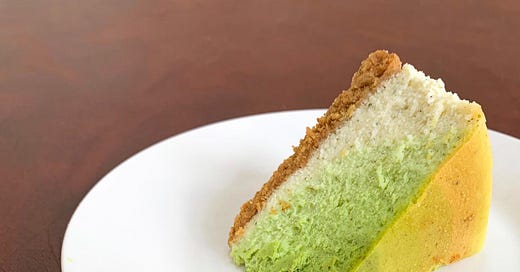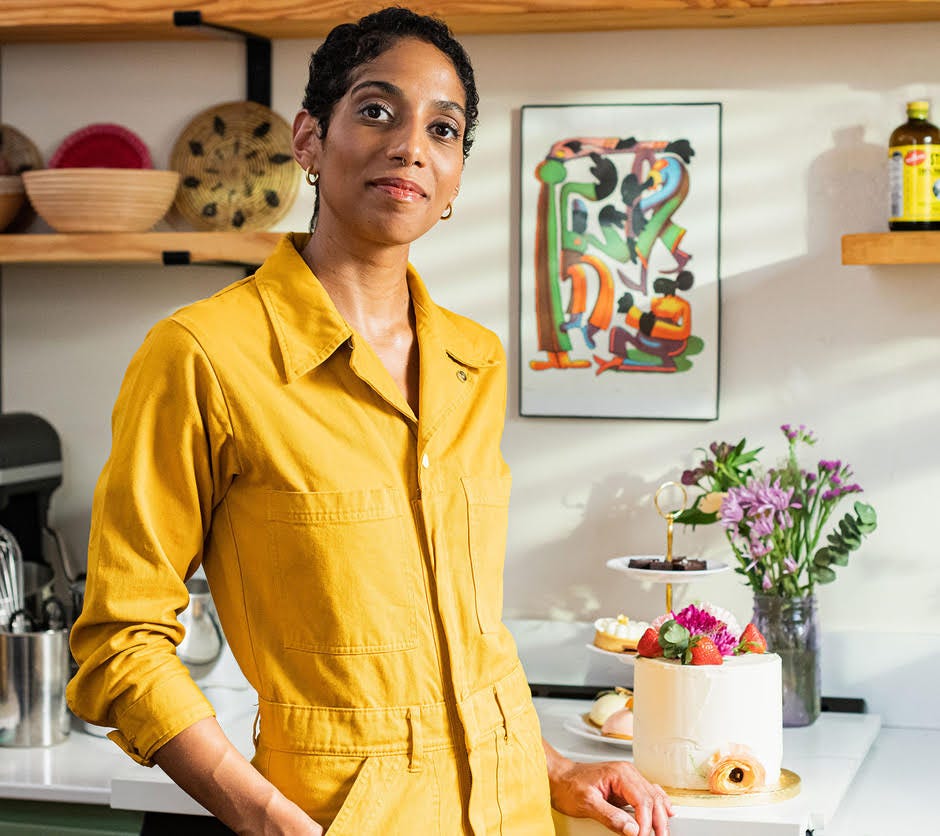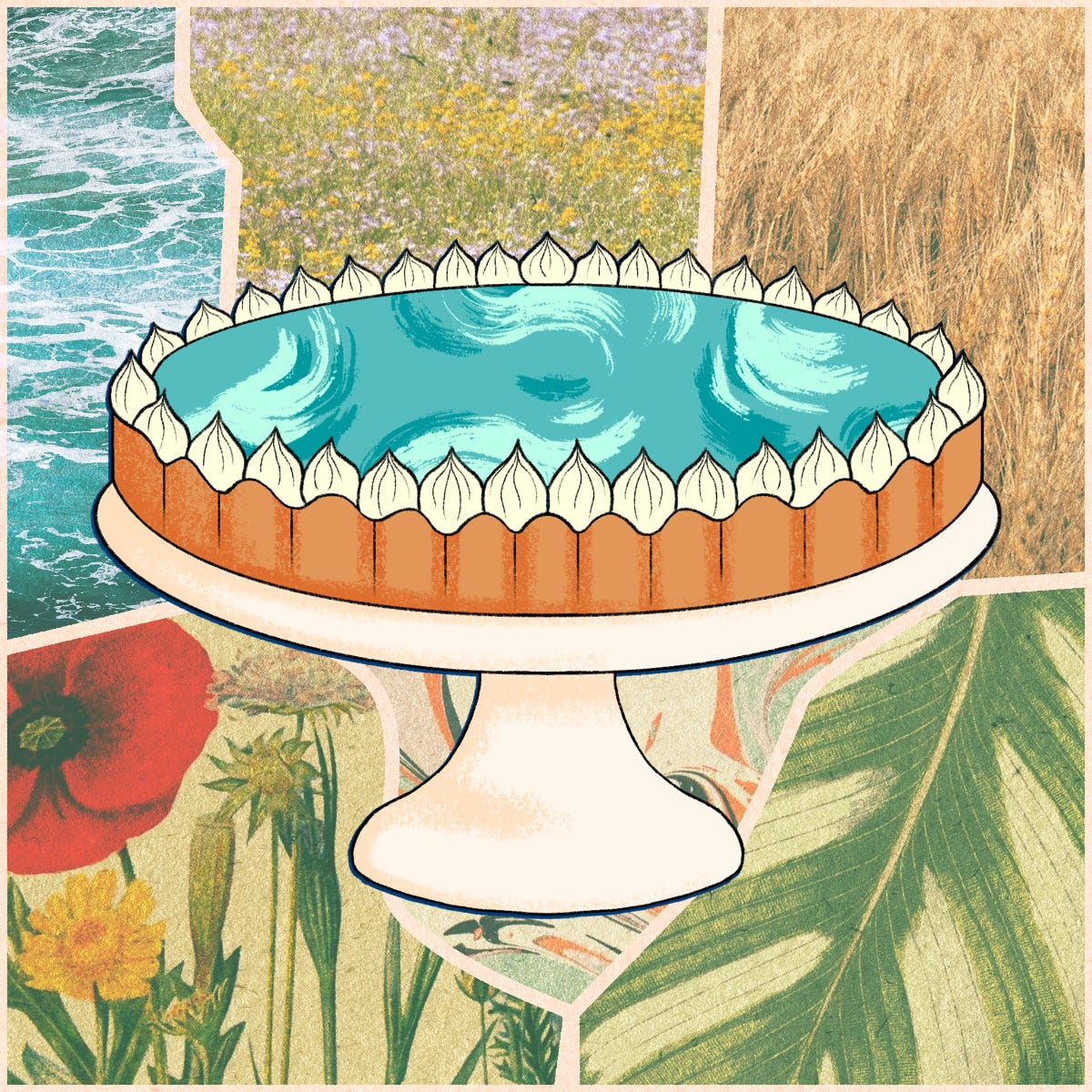Meet moringa
Pastry chef Kaitlin Guerin on baking with the magical, matcha-like ingredient that may be crucial in the climate era
This is the second in a series on baking with climate-hero ingredients. (Buckwheat was first.) Today we’re pushing past the holiday red, white, and blue to a color baking rarely sees: bright green.
It’s been called Dr. Seussian. Miracle tree. Tree of life. A nutritional swiss army knife. It’s even earned that distinctly American moniker that seems to condemn unsuspecting ingredients to the skin care aisle: superfood. Moringa is a tree—a genus of trees, really—that some researchers believe will be a crucial staple crop in the dryland tropics as climate change accelerates.
From its delicate leaves to its foot-long seed pods, moringa is a nutritional powerhouse. High in protein, amino acids, iron, calcium, and vitamins, it packs the nutritional punch of eggs and yogurt on a per-serving basis, all while sort of looking like a wacky inflatable tube man. And it thrives in hot and dry conditions, which climate change promises to spread and intensify.

First domesticated in India, moringa’s 13 species grow across some of the world’s hottest and most food-insecure regions, including parts of Africa, Asia, and beyond. It’s there that researchers see the greatest potential for moringa to be used as a staple, providing crucial nutrients in drought-prone areas where agriculture will get more challenging.
Moringa is also a culinary swiss army knife. Its leaves feature in the Senegalese beef and shellfish stew etodiaye, in Indian parethas, and in jamu, a Balinese medicinal pick-me-up drink. Its pods can be steamed in curries, and its flowers frittered.
The leaves can also be powdered—a commonly available form if you’re buying moringa in the US—and incorporated into striking desserts, like those at Lagniappe Baking in New Orleans.
Lagniappe is a popup-style bakehouse run by Kaitlin Guerin, a pastry chef known for treats and bakes that are as elegant as they are playfully nostalgic. See: her marshmallow peep ode to Annie Laura Squalls and her delightfully mini cantaloupe lime popsicles with moringa drizzle.
Kaitlin uses moringa across a range of pastries, folding it into mousses and even dipping madeleines in an emerald glaze. And she dropped by for a Q&A that gives us a delicious intro to baking with this climate-resilient ingredient.
Q&A with pastry chef Kaitlin Guerin
The following Q&A has been condensed and lightly edited for length and clarity.
Kaitlin, how did you learn about moringa, and what made you want to start baking with it?
We have a farmer friend here who has a small, black- and woman-owned urban farm in New Orleans, and she has a moringa tree. But before I discovered it from her, our friend Serigne—who owns Dakar NOLA, a Senegalese restaurant—he was always talking about this “tree of life.” And my partner's Cameroonian, and they’ve educated me on how sustainable this tree is and its health benefits.
But then he described it to me as an earthy flavor, and how in its dried powder form, it kind of takes on a matcha flavor profile. And I was like, I’d love to use that, because I don’t feel connected to matcha at all, but matcha is super popular right now, so let me take moringa and work with it instead.
I was mostly interested in it because of its West African roots. At least, that’s how I learned about it. As I’m reading more about it, I’m learning it has some other roots in Asia. And then I’m looking at the fact that it’s easy to grow in New Orleans and in a very tropical climate. So in my mind, that’s me connecting these foodways, and how things have traveled here.

How do you use moringa in your pastries?
I use it as an added herb because I want to have its grounded, earthy flavor. So I’ve used it in an ombré cheesecake; and throwing it in a pastry cream is also delicious. I like to keep it with dairy-heavy or creamy flavors, because I think it lends really well there.
I also started using moringa for color, because it makes beautiful, deep-green hues. I started using it to make sablé sandwich cookies for the color, and I was surprised because it’s a really beautiful flavor there, too. It’s definitely an earthy flavor, a taste that comes after you’ve enjoyed the cookie.

Do you have a favorite flavor to complement moringa?
It’s a heavier flavor, so it always needs something bright at the end. Ginger is top-notch. Or orange. I do the sablé cookies with a ginger caramel.
If somebody is going to bake with moringa for the first time, how would you recommend they use it?
If you have the powder, which is the more common way, I would say use it like you would any other spice: a little, at first. Start with a couple of teaspoons and then add it in for your flavor profile. Something like cheesecake is really nice, or another cream or dairy substance, like a pastry cream. If you have leaves, that’s even better, because you could steep them in cream.

Where do you get moringa?
So I am able to sometimes get my friend’s moringa. That’s the crème de la crème, but that's few and far between. I am buying it from Whole Foods right now, in powdered form. [Note for anyone who’d like to snag some: You can also get moringa online from retailers like Kuli Kuli Foods, Diaspora Co, and Amazon.]
Thanks so much, Kaitlin!
Keep up with Lagniappe
Kaitlin’s inventive pastries celebrate and reconnect southern black foodways through seasonal and local ingredients. If you find yourself in NOLA and want to snag something from Lagniappe, you can order monthly pastry boxes or find a rotating cast of breakfast pastries on the weekends at Hotel Peter and Paul and Junk Drawer Coffee. Sign up for emails via the website contact form to stay up to date on all the latest.
What’s next on Pale Blue Tart?
I was hoping you’d ask! Expect a recipe next week. Soon after that, a spread of summertime treats for the climate era is coming your way. It’ll be like reimagining pie for the climate era, but with a heat-wave bent and original illos by the artiste Amelia K. Bates.






